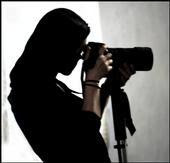Very often times composition will create light/exposure challenges. For example, very bright sky and dark ground. Another common occurrence is intentionally under- or over-exposing the image in order to capture important detail. This is common when trying to retain bright colors and highlights of the sunset or details in dark object(s) near a strong light source.
As a result of scewed exposure, portion of the photograph unavoidably contain too much dark or light areas. One of the ways of compensate for this drawback is to use HDR technique (covered in previous post). However, that may not always be possible. Further, HDR introduces "surrealistic" feel to the image, and this may not always be artistic intent. The simpler approach is to use Contrast Mask easily rendered in Photoshop (although this technique does have roots in film photography dating to nearly 100 years ago). It is best that contrast mask is applied to images in RAW format, but works just as well with JPEGs. Here's how:
As a result of scewed exposure, portion of the photograph unavoidably contain too much dark or light areas. One of the ways of compensate for this drawback is to use HDR technique (covered in previous post). However, that may not always be possible. Further, HDR introduces "surrealistic" feel to the image, and this may not always be artistic intent. The simpler approach is to use Contrast Mask easily rendered in Photoshop (although this technique does have roots in film photography dating to nearly 100 years ago). It is best that contrast mask is applied to images in RAW format, but works just as well with JPEGs. Here's how:
- Open the image and create duplicate layer of the background (Layer -> Duplicate Layer). Name your layer "Contrast Mask"
- Convert "Contrast Mask" to monochrome image (Image -> Adjust -> Desaturate)
- Covert "Contrast Mask" to negative (Image -> Adjust -> Invert)
- Apply overlay blend to the "Contrast Mask" (Layer -> Layer Style -> Blending Options. Select Blending Mode to Overlay).
- Reduce image degradation by blurring (Filter -> Blur -> Gaussian Blur. Select desired pixel radius value. Larger values tend to introduce halos on sharp contrast areas, while low amounts minigate the effect.
- Adjust opasity of "Contrast Mask" to the desired level (usually anywhere from 50-80%)
- Fine-tune the image by adjusting levels and curves to your taste (Layer -> New Adjustment Layer -> Levels/Curves. Check the box "Use Previous Layer to Create Clipping Mask" to apply changes to the "Contrast Mask").
- Flatten layers to finalize image processing.
 This image was intentionally underexposed in order to capture sun beam highlights in the sky. As a result bottom portion of the photograph is too dark. Adjusting curves or contrast of the image will sacrifice the dramatic sun beams of the sky rendering them hardly visible.
This image was intentionally underexposed in order to capture sun beam highlights in the sky. As a result bottom portion of the photograph is too dark. Adjusting curves or contrast of the image will sacrifice the dramatic sun beams of the sky rendering them hardly visible.
After applying contrast mask, the colors and highlight of the sky were retained, and initially very dark areas were brightened to reveal all the detail and color.

2 comments:
Good option, but leaves you with a halo around the foreground.
To control the "halo effect", you should experiment with pixel radius value that will either reduce or make the effect more pronounced( review step #5 in the instructions).
Also controlling opacity values can help you fine-tune the overall image to the desired result.
Post a Comment